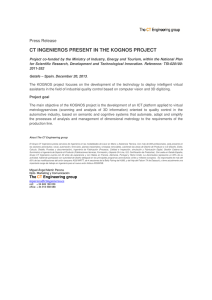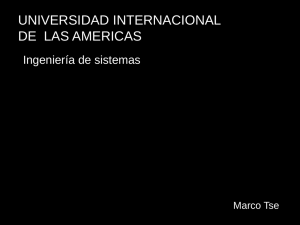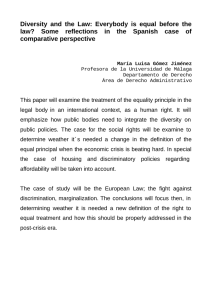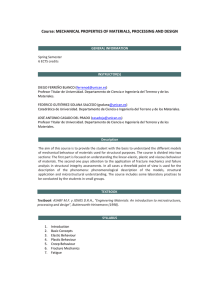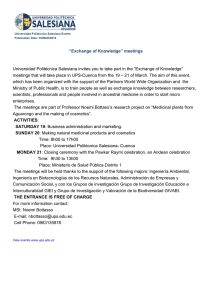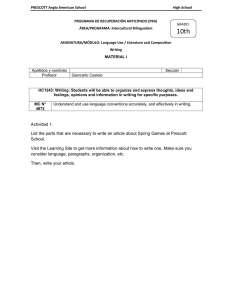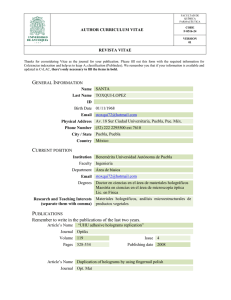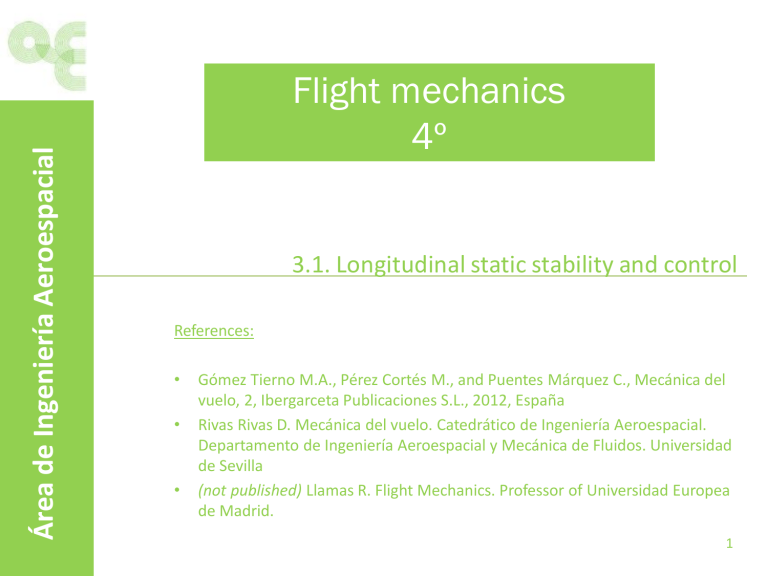
Área de Ingeniería Aeroespacial Flight mechanics 4º 3.1. Longitudinal static stability and control References: • • • Gómez Tierno M.A., Pérez Cortés M., and Puentes Márquez C., Mecánica del vuelo, 2, Ibergarceta Publicaciones S.L., 2012, España Rivas Rivas D. Mecánica del vuelo. Catedrático de Ingeniería Aeroespacial. Departamento de Ingeniería Aeroespacial y Mecánica de Fluidos. Universidad de Sevilla (not published) Llamas R. Flight Mechanics. Professor of Universidad Europea de Madrid. 1 3.1. Longitudinal static stability and control Área de Ingeniería Aeroespacial Contents. • • • • • • Introduction Total lift Total pitch moment Index of longitudinal static stability with fixed controls Methods for longitudinal control Deflection of elevator for equilibrium (trim) 2 3.1. Longitudinal static stability and control Área de Ingeniería Aeroespacial Introduction Stability Control Static Dynamic Longitudinal Lateral-directional 3 3.1. Longitudinal static stability and control Área de Ingeniería Aeroespacial Introduction • • • • • Study of major aircraft motion of rotations around the center of mass To go further, study of aircraft minor motion of rotating and articulated subsystems Center of mass trajectory under translational momentum theorem and aircraft attitude under rotational momentum theorem independently separated study of “performances” and “stability and control” The effect of control surface deflection is negligible for external forces but not for moments For aircraft with conventional configuration and symmetrical plane, motion can be brokedown in – longitudinal – lateral-directional 4 3.1. Longitudinal static stability and control Área de Ingeniería Aeroespacial Introduction • • • Angular velocity of aircraft about body axes 𝑥𝑏 , 𝑦𝑏 , 𝑧𝑏 is defined by 𝒑, 𝒒, 𝒓, respectively. Defection angles of ailerons, elevator and rudder are 𝜹𝒂 , 𝜹𝒆 , 𝜹𝒓 , respectively. Longitudinal motion: lateral and directional variables are null 𝜷, 𝝓, 𝒑, 𝒓, 𝜹𝒂 , 𝜹𝒓 = 𝟎 – Equation of forces along 𝑥𝑏 , 𝑧𝑏 – Equation of moments about 𝑦𝑏 • Lateral-directional motion: some of lateral and directional variables are not null 𝛽, 𝜙, 𝑝, 𝑟, 𝛿𝑎 , 𝛿𝑟 – All equations of forces and moments to be used • Application line of thrust on center of gravity: aircraft as glider 5 3.1. Longitudinal static stability and control Introduction Área de Ingeniería Aeroespacial • The static stability of a system is its ability to return to a configuration of equilibrium after a perturbation 6 3.1. Longitudinal static stability and control Área de Ingeniería Aeroespacial Total lift. Hypothesis • • • • • • Total lift and total pitch moment can be calculated as the addition of contributions of different aircraft parts and interferences linear functions of angle of attack. Parts: Wing (w), fuselage (b), and horizontal stabilizer (t) Wing and fuselage together in wing-fuselage set (wb) Zero lift line of wing-fuselage (LSNwb) and zero lift line of tail (LSNt) through corresponding aerodynamic centers Aerodynamic loads for each surface: – Lift: 𝐿𝑤𝑏 , 𝐿𝑡 – Drag: 𝐷𝑤𝑏 , 𝐷𝑡 – Pitch moment: 𝑀𝑎𝑐,𝑤𝑏 , 𝑀𝑎𝑐,𝑡 Moment about the aerodynamic center does not depend on angle of attack 7 3.1. Longitudinal static stability and control Área de Ingeniería Aeroespacial Total lift • Scheme of aerodynamics forces and moments for wing-fuselage and tail 8 3.1. Longitudinal static stability and control Área de Ingeniería Aeroespacial Total lift. Hypothesis • Interference of wing on horizontal tail: – Deflection of flow direction (downstream the wing): 𝜀 decrease of angle of attack of tail wrt angle of attack of wing due to induced velocity from wing vortex 𝜕𝜀 𝜀 = 𝜀0 + 𝛼 𝜕𝛼 𝑤𝑏 • 𝜀0 depends on wing twist • 𝜕𝜀 𝜕𝛼 depends on wing vortex intensity – Aerodynamic efficiency of the tail: 𝜂𝑡 reduction of dynamic pressure of flow on the tail 𝑞𝑡 wrt flow on the wing 𝑞 due to wing wake. 𝑞𝑡 𝜂𝑡 = 𝑞 9 3.1. Longitudinal static stability and control Área de Ingeniería Aeroespacial Activity 3.1.1 • According to previous scheme of forces and moments, find – lift, – drag, – lift coefficient – drag coefficient 10 3.1. Longitudinal static stability and control Área de Ingeniería Aeroespacial Total lift • According to previous scheme of forces and moments, lift, drag, lift coefficient and drag coefficient are: 𝐿 = 𝐿𝑤𝑏 + 𝐿𝑡 cos 𝜀 − 𝐷𝑡 sin 𝜀 𝐷 = 𝐷𝑤𝑏 + 𝐷𝑡 cos 𝜀 + 𝐿𝑡 sin 𝜀 𝐿 𝑆𝑡 𝑆𝑡 𝐶𝐿 = = 𝐶𝐿𝑤𝑏 + 𝐶𝐿𝑡 𝜂𝑡 cos 𝜀 − 𝐶𝐷𝑡 𝜂𝑡 sin 𝜀 𝑞𝑆 𝑆 𝑆 𝐷 𝑆𝑡 𝑆𝑡 𝐶𝐷 = = 𝐶𝐷𝑤𝑏 + 𝐶𝐷𝑡 𝜂𝑡 cos 𝜀 + 𝐶𝐿𝑡 𝜂𝑡 sin 𝜀 𝑞𝑆 𝑆 𝑆 • • 𝑆 is the wing area and 𝑆𝑡 is the horizontal tail area If deflection of flow direction is small 𝜺 ≪ 𝟏, and tail drag coefficient is much smaller than tail lift coefficient 𝑪𝑫𝒕 ≪ 𝑪𝑳𝒕: 𝐶𝐿 = • • 𝐿 𝑞𝑆 = 𝐶𝐿𝑤𝑏 + 𝐶𝐿𝑡 𝜂𝑡 𝑆𝑡 cos 𝜀 𝑆 − 𝐶𝐷𝑡 𝜂𝑡 𝑆𝑡 sin 𝜀 𝑆 𝐶𝐿 = 𝐶𝐿𝑤𝑏 + 𝐶𝐿𝑡 𝜂𝑡 𝑆𝑡 𝑆 (1) A linear model for wing and tail lift coefficients is: 𝐶𝐿𝑤𝑏 = 𝑎𝑤𝑏 𝛼𝑤𝑏 𝐶𝐿𝑡 = 𝑎𝑡 𝛼𝑡 𝛼𝑡 = 𝛼𝑤𝑏 + 𝑖𝑡 − 𝑖𝑤𝑏 − 𝜀 + 𝜏𝑒 𝛿𝑒 𝜏𝑒 is the efficiency of the elevator, and 𝛿𝑒 is the deflection of the elevator 11 3.1. Longitudinal static stability and control Total lift Área de Ingeniería Aeroespacial • If the linear model is used in equation (1) 𝜕𝜀 𝑆𝑡 𝐶𝐿 = 𝑎𝑤𝑏 𝛼𝑤𝑏 + 𝑎𝑡 𝛼𝑤𝑏 + 𝑖𝑡 − 𝑖𝑤𝑏 − 𝜀0 − 𝛼𝑤𝑏 + 𝜏𝑒 𝛿𝑒 𝜂𝑡 = 𝐶𝐿0 + 𝐶𝐿𝛼 𝛼𝑤𝑏 + 𝐶𝐿𝛿𝑒 𝛿𝑒 𝜕𝛼 𝑆 • So that: 𝑆𝑡 𝐶𝐿0 = 𝑎𝑡 𝑖𝑡 − 𝑖𝑤𝑏 − 𝜀0 𝜂𝑡 𝑆 𝑆𝑡 𝜕𝜀 𝐶𝐿𝛼 = 𝑎𝑤𝑏 + 𝑎𝑡 𝜂𝑡 1− 𝑆 𝜕𝛼 𝑆𝑡 𝐶𝐿𝛿𝑒 = 𝑎𝑡 𝜂𝑡 𝜏𝑒 𝑆 12 3.1. Longitudinal static stability and control Total lift Área de Ingeniería Aeroespacial Sign convection for control surface deflections, and moments: According to sign convention lift coefficients are: 𝛼𝑤𝑏 ↑ → 𝐶𝐿 ↑ → 𝐶𝐿𝛼 > 0 𝛿𝑒 ↑ → 𝐶𝐿 ↑ → 𝐶𝐿𝛿𝑒 > 0 Deflection of elevator affects on lift (simplification of performance studies not valid here) 13 3.1. Longitudinal static stability and control Área de Ingeniería Aeroespacial Activity 3.1.2. a) Calculate the angle 𝛼𝑤𝑏 for the zero lift line of the complete aircraft. b) If the angle of attack is referenced to this line 𝛼𝑍𝐿𝐿 = 𝛼𝑤𝑏 − 𝛼𝑤𝑏,𝐶𝐿 =0, obtain the total lift coefficient as a function of 𝛼𝑍𝐿𝐿 . 14 3.1. Longitudinal static stability and control Área de Ingeniería Aeroespacial Total pitch moment If all forces are projected on perpendicular and parallel directions to fuselage reference line: 𝑁𝑤𝑏 = 𝐿𝑤𝑏 cos 𝛼𝑤𝑏 − 𝑖𝑤𝑏 + 𝐷𝑤𝑏 sin 𝛼𝑤𝑏 − 𝑖𝑤𝑏 𝐶𝑤𝑏 = −𝐿𝑤𝑏 𝑠𝑖𝑛 𝛼𝑤𝑏 − 𝑖𝑤𝑏 + 𝐷𝑤𝑏 𝑐𝑜𝑠 𝛼𝑤𝑏 − 𝑖𝑤𝑏 𝑁𝑡 = 𝐿𝑡 cos 𝛼𝑡 − 𝑖𝑡 + 𝐷𝑡 sin 𝛼𝑡 − 𝑖𝑡 𝐶𝑡 = −𝐿𝑡 𝑠𝑖𝑛 𝛼𝑡 − 𝑖𝑡 + 𝐷𝑡 𝑐𝑜𝑠 𝛼𝑡 − 𝑖𝑡 The perpendicular and parallel force coefficients for wing-body and tail are: 𝑁𝑤𝑏 𝐶𝑁𝑤𝑏 = = 𝐶𝐿𝑤𝑏 cos 𝛼𝑤𝑏 − 𝑖𝑤𝑏 + 𝐶𝐷𝑤𝑏 sin 𝛼𝑤𝑏 − 𝑖𝑤𝑏 𝑞𝑆 𝐶𝑤𝑏 𝐶𝐶𝑤𝑏 = = −𝐶𝐿𝑤𝑏 𝑠𝑖𝑛 𝛼𝑤𝑏 − 𝑖𝑤𝑏 + 𝐶𝐷𝑤𝑏 𝑐𝑜𝑠 𝛼𝑤𝑏 − 𝑖𝑤𝑏 𝑞𝑆 𝑁𝑡 𝐶𝑁𝑡 = = 𝐶𝐿𝑡 cos 𝛼𝑡 − 𝑖𝑡 + 𝐶𝐷𝑡 sin 𝛼𝑡 − 𝑖𝑡 𝑞𝑡 𝑆𝑡 𝐶𝑡 𝐶𝐶𝑡 = = −𝐶𝐿𝑡 𝑠𝑖𝑛 𝛼𝑡 − 𝑖𝑡 + 𝐶𝐷𝑡 𝑐𝑜𝑠 𝛼𝑡 − 𝑖𝑡 𝑞𝑡 𝑆𝑡 By taking moments about the center of gravity of aircraft: 𝑀𝐴 = 𝑁𝑤𝑏 𝑥𝑎 + 𝐶𝑤𝑏 𝑧𝑎 + 𝑀𝑎𝑐,𝑤𝑏 − 𝑁𝑡 𝑙𝑡 + 𝐶𝑡 𝑧𝑡 + 𝑀𝑎𝑐,𝑡 Total aerodynamic moment coefficient is: 𝑀𝐴 𝑆𝑡 𝑙𝑡 𝑆𝑡 𝑧𝑡 𝑆𝑡 𝑐𝑡 𝐶𝑚𝐴 = = 𝐶𝑁𝑤𝑏 𝑥ҧ𝑎 + 𝐶𝐶𝑤𝑏 𝑧𝑎ҧ + 𝐶𝑀𝑎𝑐,𝑤𝑏 − 𝐶𝑁𝑡 𝜂𝑡 + 𝐶𝐶𝑡 𝜂𝑡 + 𝐶𝑀𝑎𝑐,𝑡 𝜂 𝑞𝑆𝑐 𝑆𝑐 𝑆𝑐 𝑆𝑐 𝑡 15 3.1. Longitudinal static stability and control Total pitch moment Área de Ingeniería Aeroespacial Draw all geometric parameters that affects the total moment coefficient: 16 3.1. Longitudinal static stability and control Área de Ingeniería Aeroespacial Total pitch moment Total aerodynamic moment coefficient is: 𝑀𝐴 𝑆𝑡 𝑙𝑡 𝑆𝑡 𝑧𝑡 𝑆𝑡 𝑐𝑡 𝐶𝑚𝐴 = = 𝐶𝑁𝑤𝑏 𝑥ҧ𝑎 + 𝐶𝐶𝑤𝑏 𝑧𝑎ҧ + 𝐶𝑀𝑎𝑐,𝑤𝑏 − 𝐶𝑁𝑡 𝜂𝑡 + 𝐶𝐶𝑡 𝜂𝑡 + 𝐶𝑀𝑎𝑐,𝑡 𝜂 𝑞𝑆𝑐 𝑆𝑐 𝑆𝑐 𝑆𝑐 𝑡 • 𝑆𝑙 Where 𝑉ത𝑡 = 𝑡 𝑡 is the volumen coefficient of horizontal tail • If angles are small, 𝐶𝐷𝑤𝑏 ≪ 𝐶𝐿𝑤𝑏 , 𝐶𝐷𝑡 ≪ 𝐶𝐿𝑡 , and symetrical or quasi-symetrical tail airfoil, the total moment coefficient is: 𝑆𝑐 𝐶𝑚𝐴 = 𝐶𝐿𝑤𝑏 𝑥ҧ𝑎 + 𝐶𝑀𝑎𝑐,𝑤𝑏 − 𝐶𝐿𝑡 𝑉ത𝑡 𝜂𝑡 = 𝐶𝐿𝑤𝑏 (𝑥ҧ𝑐𝑔 − 𝑥ҧ𝑎𝑐,𝑤𝑏 ) + 𝐶𝑀𝑎𝑐,𝑤𝑏 − 𝐶𝐿𝑡 𝑉ത𝑡 𝜂𝑡 • If values of 𝐶𝐿𝑤𝑏 and 𝐶𝐿𝑡 are included: 𝐶𝑚𝐴 = 𝐶𝑚0 + 𝐶𝑚𝛼 𝛼𝑤𝑏 + 𝐶𝑚𝛿𝑒 𝛿𝑒 Where 𝐶𝑚0 = 𝐶𝑀𝑎𝑐,𝑤𝑏 − 𝑎𝑡 𝜂𝑡 𝑉ത𝑡 𝑖𝑡 − 𝑖𝑤𝑏 − 𝜀0 𝐶𝑚𝛼 = 𝑎𝑤𝑏 𝑥ҧ𝑐𝑔 − 𝑥ҧ𝑎𝑐,𝑤𝑏 − 𝑎𝑡 𝜂𝑡 𝑉ത𝑡 1 − 𝜕𝜀 𝜕𝛼 𝐶𝑚𝛿𝑒 = −𝑎𝑡 𝜂𝑡 𝑉ത𝑡 𝜏𝑒 17 3.1. Longitudinal static stability and control Área de Ingeniería Aeroespacial Total pitch moment. Analysis of moment coefficients 𝑪𝒎𝜶 : Index of longitudinal static stability with fixed controls. For static stability: 𝛼𝑤𝑏 ↑ → 𝐶𝑚𝐴 ↓ → 𝐶𝑚𝛼 < 0 𝑪𝒎𝜹𝒆 : Longitudinal control power: 𝛿𝑒 ↑ → 𝐶𝑚𝐴 ↓ → 𝐶𝑚𝛿𝑒 < 0 Note: According to sign convention, the moment coefficients associated to the other two control surface deflections are: 𝐿𝐴 𝛿𝑎 ↑ → 𝐶𝑙𝐴 = ↑ → 𝐶𝑙𝛿𝑎 > 0 𝑞𝑆𝑐 𝑁𝐴 𝛿𝑟 ↑ → 𝐶𝑛𝐴 = ↑ → 𝐶𝑛𝛿𝑟 > 0 𝑞𝑆𝑐 18 3.1. Longitudinal static stability and control Área de Ingeniería Aeroespacial Index of longitudinal static stability with fixed controls • • • • For a static stable aircraft to return to a configuration of equilibrium after a perturbation, it has to produce “automatically” the forces and moments that oppose the perturbation forces and moments. The main perturbation to analyze in case of longitudinal static stability is the change of the angle of attack. 𝛼𝑤𝑏 ↑ → 𝐶𝑚𝐴 ↓ Criterion for longitudinal static stability against perturbation of angle of attack, with fixed controls (constant 𝛿𝑒 ) and constant load factor n: < 0 𝑠𝑡𝑎𝑏𝑙𝑒 𝜕𝐶𝑚 𝜕𝐶𝑚𝐴 = = 𝐶𝑚𝛼 = ቐ = 0 𝑛𝑒𝑢𝑡𝑟𝑎𝑙 𝜕𝛼𝑤𝑏 𝛿 ,𝑛 𝜕𝛼𝑤𝑏 𝛿 ,𝑛 > 0 𝑢𝑛𝑠𝑡𝑎𝑏𝑙𝑒 𝑒 𝑒 Modifying the center of gravity of the aircraft changes stability: 𝜕𝜀 𝐶𝑚𝛼 = 𝑎𝑤𝑏 𝑥ҧ𝑐𝑔 − 𝑥ҧ 𝑎𝑐,𝑤𝑏 − 𝑎𝑡 𝜂𝑡 𝑉ത𝑡 1 − 𝜕𝛼 19 3.1. Longitudinal static stability and control Área de Ingeniería Aeroespacial Index of longitudinal static stability with fixed controls • Neutral point with fixed controls: 𝑁0 = 𝑥ҧ𝑐𝑔 , so that 𝐶𝑚𝛼 =0 𝑎𝑡 𝜂𝑡 𝑉ത𝑡 𝜕𝜀 𝑁0 = 𝑥ҧ𝑎𝑐,𝑤𝑏 + 1− → 𝑪𝒎𝜶 = 𝒂𝒘𝒃 ഥ 𝒙𝒄𝒈 − 𝑵𝟎 𝑎𝑤𝑏 𝜕𝛼 • Static margin with fixed control: 𝐻0 = 𝑁0 − 𝑥ҧ𝑐𝑔 • Neutral point is a rear limit for position of center of gravity • …to be continued at last slight… 20 3.1. Longitudinal static stability and control Index of longitudinal static stability with fixed controls Área de Ingeniería Aeroespacial • Pitching moment coefficient about the center of gravity : 21 3.1. Longitudinal static stability and control Área de Ingeniería Aeroespacial Methods for longitudinal control • Controllability: respond of the aircraft after pilot actuation from a initial to final steady states, or during unsteady manourvers. – Static controllability: • focused on relationships between – steady flight conditions – deflections – level forces from pilots to mantain steady conditions – Longitudinal static controllability: • focused on relationships between – the values of the angle of attack or velocity in steady flight conditions – deflection of elevator – level force from pilot on longitudinal control 22 3.1. Longitudinal static stability and control Methods for longitudinal control Área de Ingeniería Aeroespacial • For equilibrated steady and straight fligth at given angle of attack: −𝐶𝑚0 − 𝐶𝑚𝛿𝑒 𝛿𝑒 𝐶𝑚 = 𝐶𝑚𝐴 = 𝐶𝑚0 + 𝐶𝑚𝛼 𝛼𝑤𝑏,𝑒 + 𝐶𝑚𝛿𝑒 𝛿𝑒 = 0 → 𝛼𝑤𝑏,𝑒 = 𝐶𝑚𝛼 where 𝐶𝑚0 = 𝐶𝑀𝑎𝑐,𝑤𝑏 − 𝑎𝑡 𝜂𝑡 𝑉ത𝑡 𝑖𝑡 − 𝑖𝑤𝑏 − 𝜀0 𝜕𝜀 𝐶𝑚𝛼 = 𝑎𝑤𝑏 𝑥ҧ𝑐𝑔 − 𝑥ҧ𝑎𝑐,𝑤𝑏 − 𝑎𝑡 𝜂𝑡 𝑉ത𝑡 1 − 𝜕𝛼 𝐶𝑚𝛿𝑒 = −𝑎𝑡 𝜂𝑡 𝑉ത𝑡 𝜏𝑒 • Methods to change the angle of attack for equilibrium 𝛼𝑤𝑏,𝑒 , so that flight conditions can be changed: – – – • Change of 𝐶𝑚0 : deflection of flaps change of wing-body pitching moment coefficient 𝐶𝑀𝑎𝑐,𝑤𝑏 Change of position of center of gravity: modify the angle of attack but also the index of static stability 𝐶𝑚𝛼 . Deflection of elevator: modify 𝐶𝑚𝛿𝑒 𝛿𝑒 Aircraft use third method except hang-glider that changes the second one 23 3.1. Longitudinal static stability and control Área de Ingeniería Aeroespacial Deflection of elevator for equilibrium (trim) • From longitudinal equilibrium, the deflection of elevator to flight at different equilibrium angles of attack: 𝐶𝑚0 𝐶𝑚𝛼 𝐶𝑚𝛼 𝛿𝑒 = − − 𝛼𝑤𝑏,𝑒 = 𝛿𝑒0 − 𝛼 𝐶𝑚𝛿𝑒 𝐶𝑚𝛿𝑒 𝐶𝑚𝛿𝑒 𝑤𝑏,𝑒 • Relationship between index of static stability and 𝑑𝛿𝑒 Τ𝑑𝛼𝑤𝑏,𝑒 : 𝑑𝛿𝑒 𝐶𝑚𝛼 𝑑𝛿𝑒 =− → 𝑠𝑖𝑔𝑛 = 𝑠𝑖𝑔𝑛 𝐶𝑚𝛼 𝑑𝛼𝑤𝑏,𝑒 𝐶𝑚𝛿𝑒 𝑑𝛼𝑤𝑏,𝑒 • Elevator angle vs angle of attack for trim • Generally, at low speeds the elevator has negative deflection for trim and at higher speeds the deflection becomes positive 24 3.1. Longitudinal static stability and control Área de Ingeniería Aeroespacial Deflection of elevator for equilibrium (trim) • If elevator angle for trim is used in the lift coefficient, lift coefficient for trim is: 𝐶𝐿𝑒 = 𝐶𝐿0 + 𝐶𝐿𝛼 𝛼𝑤𝑏,𝑒 + 𝐶𝐿𝛿𝑒 𝛿𝑒 𝐶𝑚0 𝐶𝑚𝛼 = 𝐶𝐿0 + 𝐶𝐿𝛼 𝛼𝑤𝑏,𝑒 + 𝐶𝐿𝛿𝑒 − − 𝛼 𝐶𝑚𝛿𝑒 𝐶𝑚𝛿𝑒 𝑤𝑏,𝑒 𝐶𝑚0 𝐶𝑚𝛼 = 𝐶𝐿0 − 𝐶𝐿𝛿𝑒 + 𝐶𝐿𝛼 − 𝐶 𝛼 𝐶𝑚𝛿𝑒 𝐶𝑚𝛿𝑒 𝐿𝛿𝑒 𝑤𝑏,𝑒 • Slope of the lift coefficient for trim 𝑑𝐶𝐿𝑒 Τ𝑑𝛼𝑤𝑏,𝑒 : 𝑑𝐶𝐿𝑒 𝐶𝑚𝛼 = 𝐶𝐿𝛼 − 𝐶 𝑑𝛼𝑤𝑏,𝑒 𝐶𝑚𝛿𝑒 𝐿𝛿𝑒 → 𝐶𝐿𝛿𝑒 > 0 , 𝐶𝑚𝛼 < 0 𝑖𝑓 𝑠𝑡𝑎𝑏𝑙𝑒, 𝐶𝑚𝛿𝑒 < 0 → 𝑑𝐶𝐿𝑒 < 𝐶𝐿𝛼 𝑑𝛼𝑤𝑏,𝑒 Slope of total lift coefficient for trim is smaller than slope of wing-body lift coefficient 25 3.1. Longitudinal static stability and control Área de Ingeniería Aeroespacial Index of longitudinal static stability with fixed controls (II) • • • …continuation of slight 4… For stable flight, there is a front limit for position of center of gravity due to the need of compensate up to the stall angle of attack for trim: 𝛼𝑤𝑏,𝑒,𝑚𝑎𝑥 When the stall angle occurs, the deflection of elevator is minimum (negative and upwards): 𝛿𝑒,𝑚𝑖𝑛 𝐶𝑚𝛼 𝐶𝑚𝛼 𝛿𝑒 = 𝛿𝑒0 − 𝛼𝑤𝑏,𝑒 → 𝛿𝑒,𝑚𝑖𝑛 = 𝛿𝑒0 − 𝛼 𝐶𝑚𝛿𝑒 𝐶𝑚𝛿𝑒 𝑤𝑏,𝑒,𝑚𝑎𝑥 𝛼𝑤𝑏,𝑒,𝑚𝑎𝑥 To be reminded that 𝐶𝑚𝛿𝑒 < 0 and 𝐶𝑚𝛼 < 0 • At this configuration: 𝐶𝑚𝛼 = 𝑎𝑤𝑏 𝑥ҧ𝑐𝑔,𝑙𝑖𝑚,𝑓𝑟𝑜𝑛𝑡 − 𝑁0 𝐶𝑚𝛿𝑒 𝛿𝑒,𝑚𝑖𝑛 − 𝛿𝑒0 𝐶𝑚𝛿𝑒 𝛿𝑒0 − 𝛿𝑒,𝑚𝑖𝑛 𝐶𝑚𝛼 = − = 𝛼𝑤𝑏,𝑒,𝑚𝑎𝑥 𝛼𝑤𝑏,𝑒,𝑚𝑎𝑥 𝐶𝑚𝛿𝑒 𝛿𝑒0 − 𝛿𝑒,𝑚𝑖𝑛 ഥ 𝒙𝒄𝒈,𝒍𝒊𝒎,𝒇𝒓𝒐𝒏𝒕 = 𝑁0 + 𝑎𝑤𝑏 𝛼𝑤𝑏,𝑒,𝑚𝑎𝑥 26
